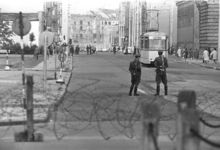Berlin celebrates its reunification
Historical storytelling. This is what the ceremony was all about that took place at the New Apostolic Church in Berlin (Germany). It was about separation, reunification, and growing together. Video clips were used to take the audience on a journey through time and through a city with a unique fate.
“East – West, East – West.” A little boy jumps from one side of a line of cobblestones on the ground to the other. Double rows of cobblestones mark the former course of the 160-kilometre Berlin Wall—the wall that once separated West and East Germany. The seven-year-old boy is the son of the Kracks. The boy’s parents met and fell in love when the two Berlin Church districts were reunited: “When you love each other it doesn’t matter whether you come from Uruguay or China.”
It was stories like these that were told during the celebration at the beginning of January 2017 marking the reunification of the two districts. Nearly 25 years to the day, the two Apostle districts East and West were reunited. The look back in the congregation of Prenzlauer Berg used mainly video material. The clip of the boy jumping back and forth over the cobblestones was from 2008, and was the first of a whole series of video clips.
The separation
“Werner, we can’t get across any more.” Priest Simon is on his way to his congregation in Hussiten Street on that Sunday in August 1961, when a friend comes to meet him: “The border is closed.” In the heart of Berlin, barbed wire and barricades block the way. Before long these will be replaced by the infamous Berlin Wall. Their congregation is a mere stone’s throw away, but for Werner Simon and more than 200 other brothers and sisters it is beyond reach—and that for several decades. They find a new home for their soul in Duncker Street.
East – West: District Elder Simon, now retired, was one of the witnesses of that time who took the audience in January 2017 on a video journey through time and to important historic sites. “The wall shattered, separated, and destroyed a lot,” he says. In one of the videos, Evangelist (ret.) Günter Brücher spoke about the “religious adventures” in the West.
The reunification
“It was and is the same love that brought sacrifices here and there and built up the Lord’s work over years and decades,” Chief Apostle Richard Fehr said on 5 January 1992 in the congregation of Lichtenberg. “I am very happy that as of today we will not be talking about the districts of West Berlin and East Berlin any more, because I now officially unite the two into a single district, namely Berlin.”
Emotionally, such mergers are not easy, Chief Apostle Jean-Luc Schneider said exactly 25 years and two days later. But such bonds must not become more important than the gospel itself. “The more important Jesus Christ becomes, as opposed to our person and our emotions, the stronger the work of God will be.”
Joyful community
In paying tribute, the retired District Apostle Wilfried Klingler said that the reunification “was a success in bringing people with different backgrounds together in a confined space and creating one joyful community”.
In the course of the evening, the choir—accompanied by a pianist—sang the hymn that had been sung as opening hymn a quarter of a century earlier: “Heart with heart in love united”.
Photo: Horst-Dieter Kämpfer
Article info
Author:
Date:
Keywords:
Andreas Rother,
Daniel Mauthe,
Oliver Rütten
31.01.2017
Germany,
Chief Apostle,
Divine service,
People/Personalities,
Congregational life,
Structure





